The Best Maple Trees to Plant in Your Garden: A Guide to Species Selection
Published: August 22, 2025 at 9:07:54 AM UTC
Maple trees stand as living sculptures in the garden, offering a perfect blend of beauty and function. With their distinctive leaf shapes, spectacular fall colors, and architectural branching patterns, maples can transform any outdoor space into a showcase of seasonal splendor. Whether you're seeking dappled shade, vibrant autumn displays, or a focal point for your landscape design, the right maple variety can fulfill multiple roles while supporting local wildlife and enhancing your property's appeal. With over 100 species in the Acer genus, selecting the best maple trees for gardens requires understanding which varieties will thrive in your specific conditions. This guide explores the most garden-worthy maple species, helping you choose the perfect tree for your space, climate, and aesthetic preferences.
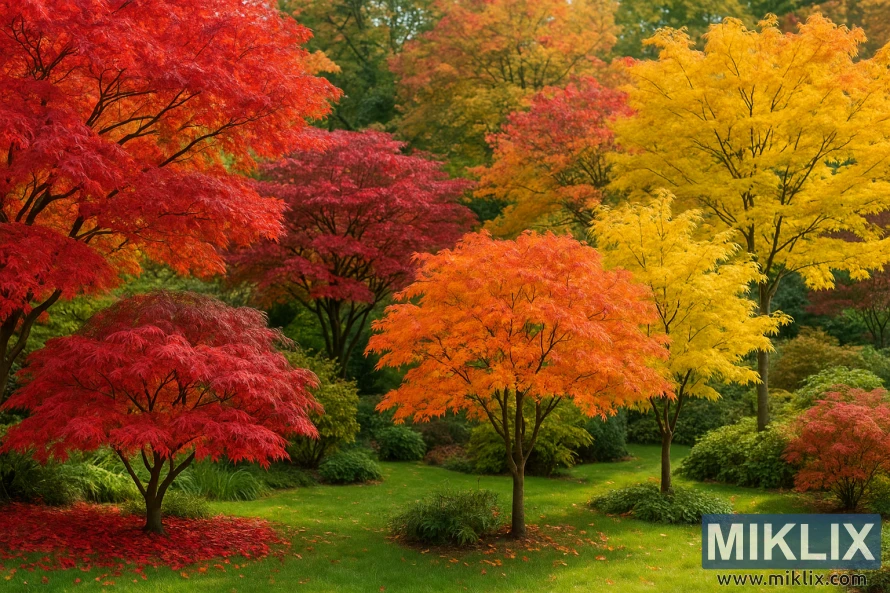
What Makes Maple Trees Ideal for Gardens?
Maple trees have earned their place as garden favorites for several compelling reasons. Their distinctive lobed leaves create interesting textures throughout the growing season, while their fall transformation into fiery shades of red, orange, and yellow provides unmatched seasonal drama. Many maple species offer additional ornamental features like interesting bark patterns, attractive seed pods (samaras), and elegant branching structures that provide winter interest.
Beyond aesthetics, maples offer practical benefits as landscape trees. Many varieties provide excellent shade, create wildlife habitat, and adapt to various soil conditions. With options ranging from compact Japanese maples perfect for small gardens to majestic sugar maples that can anchor larger landscapes, there's a maple tree suited for nearly every garden situation.
8 Best Maple Trees for Gardens
After evaluating dozens of maple species for garden performance, adaptability, and ornamental value, we've identified these eight outstanding varieties that excel in residential landscapes. Each offers a unique combination of features that make them ideal choices for garden settings.
Japanese
1. Japanese Maple (Acer palmatum)
Japanese maples are the quintessential ornamental maple for gardens, prized for their delicate foliage, compact size, and extraordinary seasonal color. These versatile trees work beautifully as focal points, in containers, or as understory plantings beneath larger trees.
- Mature size: 15-25 feet tall and wide (varies by cultivar)
- Growth rate: Slow (less than 1 foot per year)
- Key characteristics: Finely dissected or palmate leaves, vibrant fall colors ranging from golden yellow to deep crimson, elegant branching pattern
- USDA zones: 5-9 (some cultivars hardy to zone 4)
- Garden suitability: Small gardens, Japanese-inspired landscapes, shade gardens, containers
Popular cultivars include 'Bloodgood' (deep purple foliage), 'Crimson Queen' (weeping form with red leaves), and 'Sango Kaku' (coral bark maple with striking winter stem color).
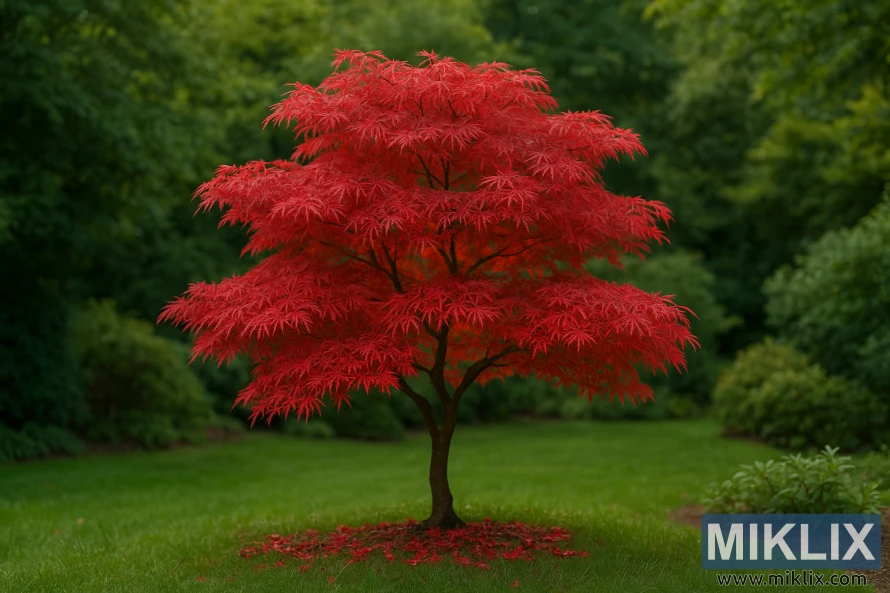
2. Red Maple (Acer rubrum)
The red maple combines rapid growth with spectacular fall color, making it one of North America's most popular landscape trees. Its adaptability to various soil conditions and reliable autumn display have earned it a place in countless gardens.
- Mature size: 40-60 feet tall, 30-40 feet wide
- Growth rate: Fast (1-2 feet per year)
- Key characteristics: Three to five-lobed leaves with serrated edges, brilliant red fall foliage, red flowers and seeds in spring
- USDA zones: 3-9
- Garden suitability: Larger gardens, shade trees, street plantings, wet areas
Notable cultivars include 'October Glory' (extended fall color), 'Red Sunset' (reliable scarlet fall display), and 'Autumn Blaze' (hybrid with silver maple offering fast growth and excellent color).
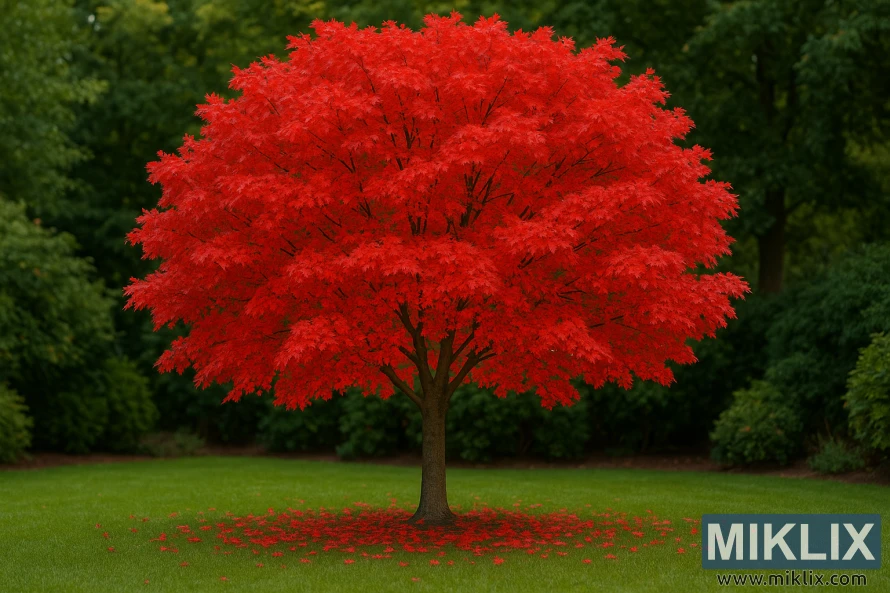
3. Sugar Maple (Acer saccharum)
The iconic sugar maple is renowned for its spectacular fall display and is the primary source of maple syrup. Though larger than some garden trees, its magnificent form and reliable autumn color make it worth accommodating in spacious landscapes.
- Mature size: 60-75 feet tall, 40-50 feet wide
- Growth rate: Moderate (1 foot per year)
- Key characteristics: Five-lobed leaves with smooth margins, outstanding orange-red fall color, symmetrical oval crown
- USDA zones: 3-8
- Garden suitability: Large properties, shade trees, native gardens, fall color specimens
Look for cultivars like 'Legacy' (heat tolerance), 'Green Mountain' (drought resistance), and 'Fall Fiesta' (exceptional fall color) for enhanced garden performance.
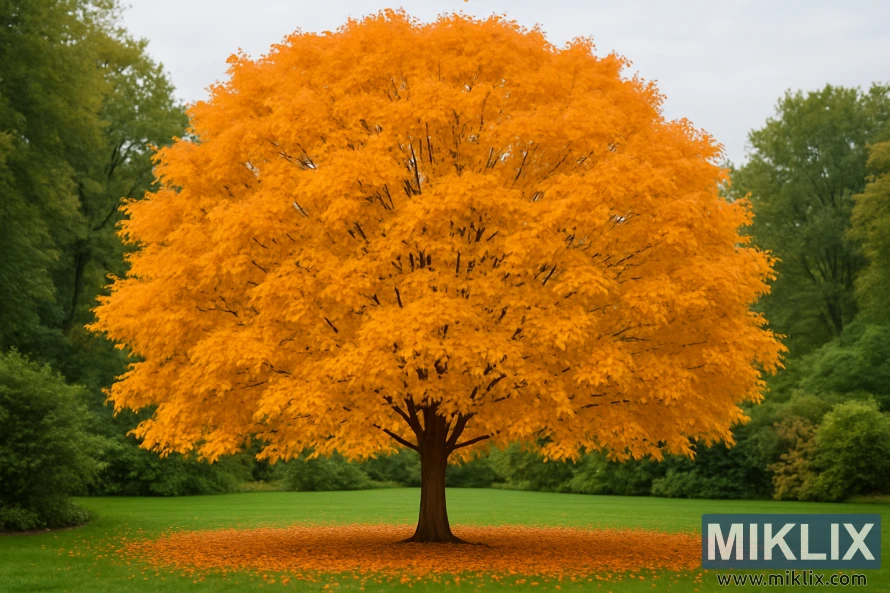
4. Paperbark Maple (Acer griseum)
The paperbark maple stands out for its extraordinary exfoliating cinnamon-colored bark, which creates year-round interest even after its leaves have fallen. This slow-growing tree makes an exceptional focal point in garden settings.
- Mature size: 20-30 feet tall, 15-25 feet wide
- Growth rate: Slow to moderate
- Key characteristics: Exfoliating cinnamon-red bark, trifoliate leaves, scarlet-orange fall color
- USDA zones: 4-8
- Garden suitability: Specimen tree, winter interest, small to medium gardens
This tree requires little pruning and looks spectacular when positioned where winter sunlight can illuminate its peeling bark. Consider planting where it can be viewed from multiple angles to appreciate its unique texture.
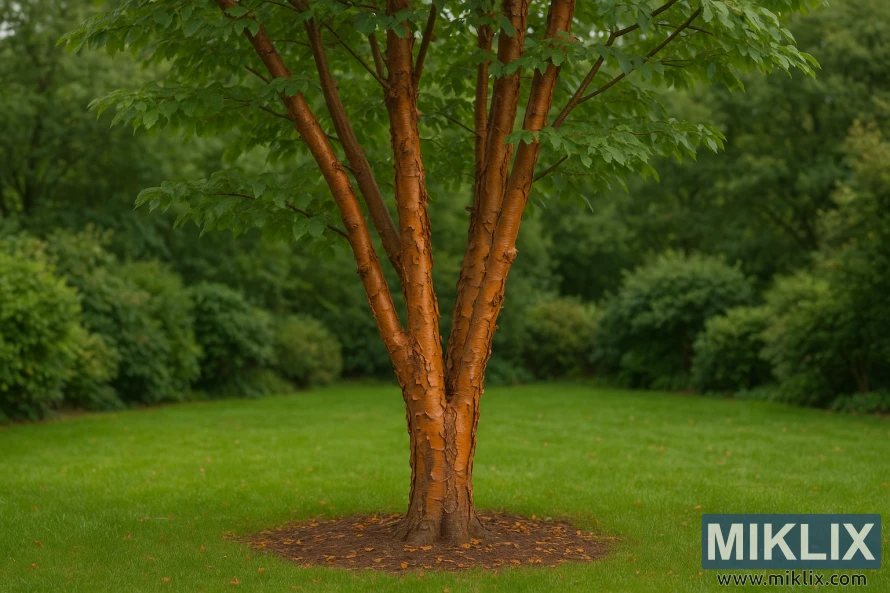
5. Amur Maple (Acer ginnala)
The Amur maple is a versatile small tree or large shrub that excels in compact gardens. Its outstanding fall color and adaptability to various growing conditions make it an excellent choice where space is limited.
- Mature size: 15-20 feet tall and wide
- Growth rate: Moderate
- Key characteristics: Three-lobed leaves, fragrant spring flowers, brilliant red fall color, drought tolerance
- USDA zones: 3-8
- Garden suitability: Small gardens, hedges, screens, urban settings
The 'Flame' cultivar offers particularly intense scarlet fall color, while 'Compactum' stays even smaller at about 10 feet tall, perfect for tight spaces.
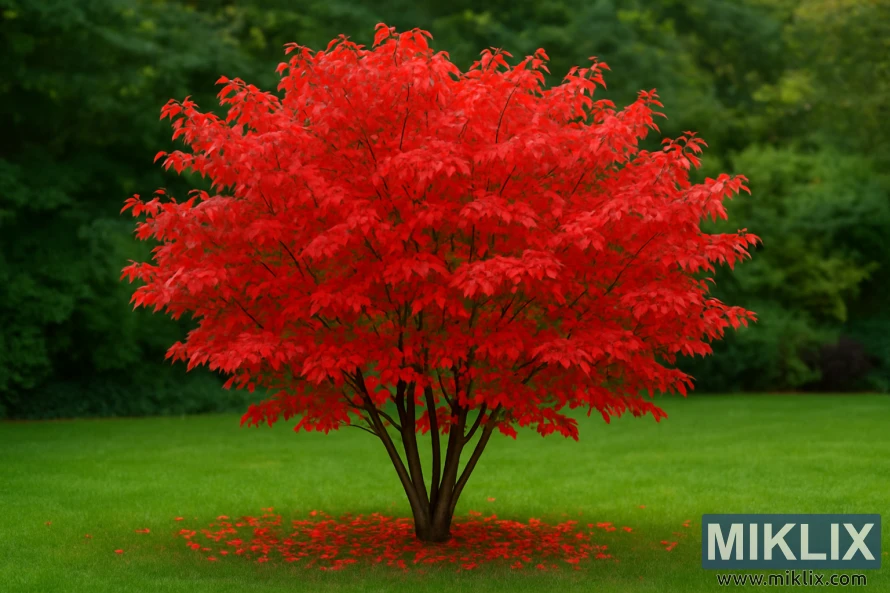
6. Trident Maple (Acer buergerianum)
The trident maple is an excellent choice for warmer regions, offering heat and drought tolerance along with attractive three-lobed leaves. Its moderate size and adaptability to urban conditions make it increasingly popular in garden settings.
- Mature size: 20-30 feet tall, 20-25 feet wide
- Growth rate: Moderate
- Key characteristics: Distinctive three-lobed leaves, exfoliating bark on mature specimens, yellow to red fall color
- USDA zones: 5-9
- Garden suitability: Urban gardens, street trees, drought-prone areas, patios
This versatile tree can be grown as a multi-stemmed specimen or trained to a single trunk, and it responds well to pruning, making it suitable for smaller spaces.
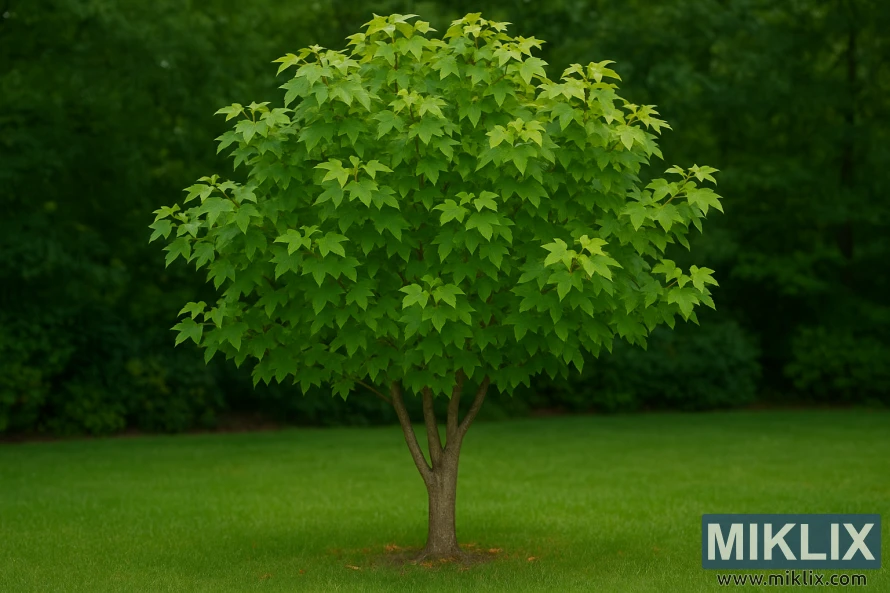
7. Shantung Maple (Acer truncatum)
The Shantung maple is gaining popularity for its combination of ornamental features and environmental resilience. Its star-shaped leaves emerge with purple-red tints before turning green, then transform to orange-red in fall.
- Mature size: 20-25 feet tall and wide
- Growth rate: Moderate
- Key characteristics: Star-shaped leaves with purple spring emergence, glossy summer foliage, excellent fall color, heat and drought tolerance
- USDA zones: 4-8
- Garden suitability: Urban settings, street trees, heat-prone areas, medium-sized gardens
The 'Fire Dragon' cultivar offers particularly vibrant fall color, while hybrid crosses with Norway maple (like 'Norwegian Sunset') combine the best traits of both species.
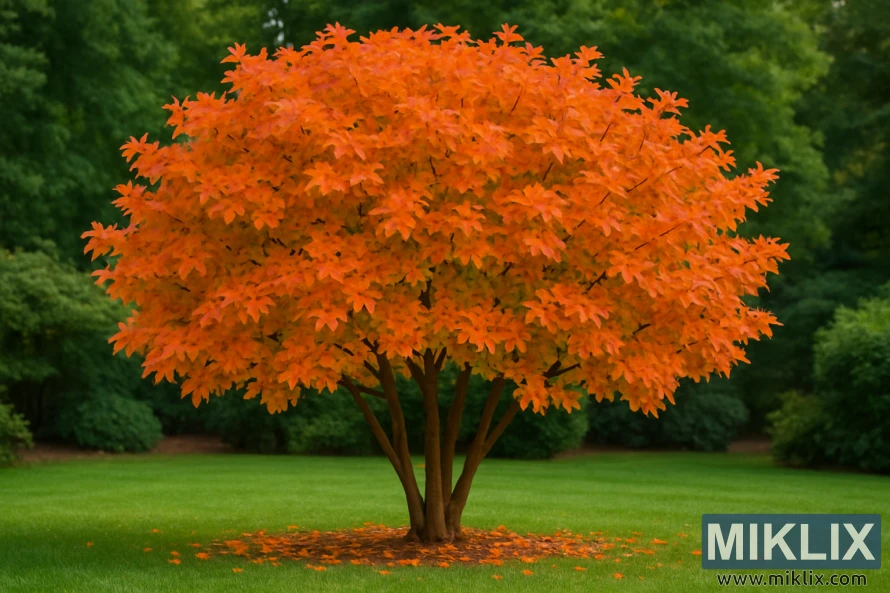
8. Fullmoon Maple (Acer shirasawanum)
The fullmoon maple offers a distinctive alternative to the more common Japanese maple, featuring rounded, fan-shaped leaves that resemble a full moon. This elegant tree provides similar ornamental value but with its own unique character.
- Mature size: 15-25 feet tall and wide
- Growth rate: Slow to moderate
- Key characteristics: Rounded, fan-shaped leaves with 9-13 shallow lobes, golden yellow to orange-red fall color
- USDA zones: 5-7
- Garden suitability: Specimen tree, Japanese gardens, woodland settings, partial shade areas
The 'Aureum' cultivar (golden fullmoon maple) features chartreuse-yellow leaves that turn golden in fall, creating a luminous effect in partially shaded settings.
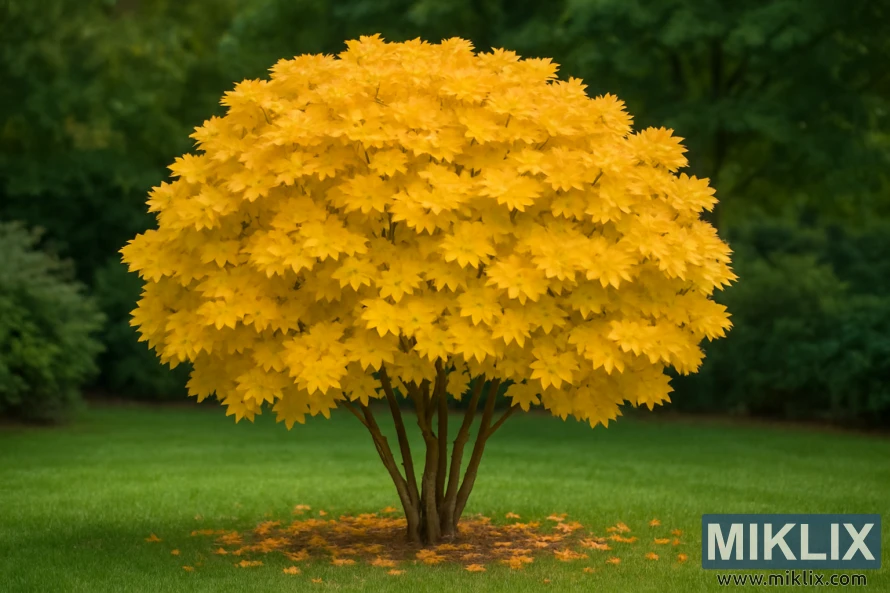
Maple Tree Comparison Chart
Use this quick reference guide to compare key features of our recommended maple varieties and determine which best suits your garden needs.
| Maple Species | Mature Height | Growth Rate | Fall Color | USDA Zones | Special Features |
| Japanese Maple | 15-25 ft | Slow | Red to Purple | 5-9 | Delicate foliage, compact size |
| Red Maple | 40-60 ft | Fast | Bright Red | 3-9 | Adaptable, reliable fall color |
| Sugar Maple | 60-75 ft | Moderate | Orange-Red | 3-8 | Syrup production, shade |
| Paperbark Maple | 20-30 ft | Slow-Moderate | Scarlet-Orange | 4-8 | Exfoliating bark, winter interest |
| Amur Maple | 15-20 ft | Moderate | Brilliant Red | 3-8 | Drought tolerance, compact size |
| Trident Maple | 20-30 ft | Moderate | Yellow-Red | 5-9 | Heat tolerance, urban adaptability |
| Shantung Maple | 20-25 ft | Moderate | Orange-Red | 4-8 | Heat resistance, star-shaped leaves |
| Fullmoon Maple | 15-25 ft | Slow-Moderate | Golden-Orange | 5-7 | Unique rounded leaves |
Best Maple Trees for Specific Garden Needs
Different garden situations call for specific maple varieties. Here are our top recommendations for common landscape scenarios.
Best Maples for Small Gardens
Limited space doesn't mean you can't enjoy the beauty of maple trees. These compact varieties deliver big impact in small footprints:
- Japanese Maple - Especially dwarf cultivars like 'Shaina' (5-7 feet) or 'Red Dragon' (5-8 feet)
- Amur Maple - Can be maintained as a large shrub through pruning
- Fullmoon Maple - Slower growth rate and moderate size make it suitable for smaller spaces
For extremely limited spaces, consider container-grown Japanese maples, which can thrive for years in large pots on patios or balconies.
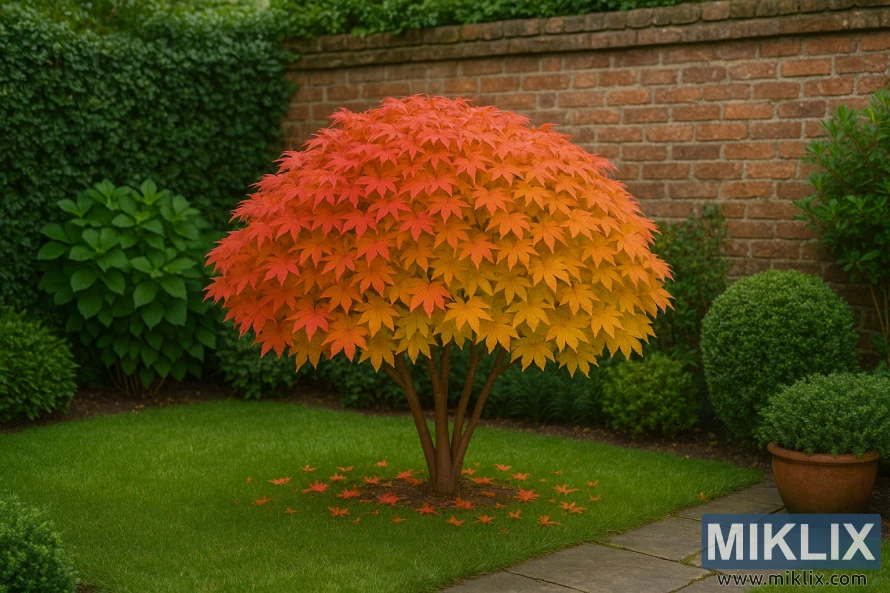
Fastest Growing Maple Trees
When shade is needed quickly, these fast-growing maple varieties deliver results:
- Red Maple - Grows 1-2 feet per year with excellent fall color
- Freeman Maple - Hybrid vigor produces rapid growth (cultivars like 'Autumn Blaze')
- Silver Maple - Very fast growth (2-3 feet per year) but less desirable structure
Note that the fastest-growing maples often have weaker wood and shorter lifespans. For a balance of reasonable growth rate and structural strength, red maple is often the best choice.
Most Drought-Tolerant Maple Trees
For gardens in dry regions or areas with water restrictions, these maple varieties offer the best drought tolerance:
- Trident Maple - Excellent urban tree with good drought resistance once established
- Shantung Maple - Handles heat and periodic dry conditions well
- Amur Maple - Surprisingly drought-tolerant for a northern species
Even drought-tolerant maples benefit from regular watering during their establishment period (first 2-3 years) and during extended dry spells.
Best Maple Trees for Fall Color
If spectacular autumn displays are your priority, these maple varieties offer the most reliable and vibrant fall color:
- Sugar Maple - The gold standard for orange-red fall foliage
- Red Maple - Dependable scarlet display, especially 'October Glory' and 'Red Sunset' cultivars
- Japanese Maple - Varieties like 'Osakazuki' and 'Emperor I' offer intense crimson fall color
- Amur Maple - Brilliant red fall color even in northern regions
For the most intense fall colors, plant maples where they receive full sun for at least part of the day, as shade can diminish color development.
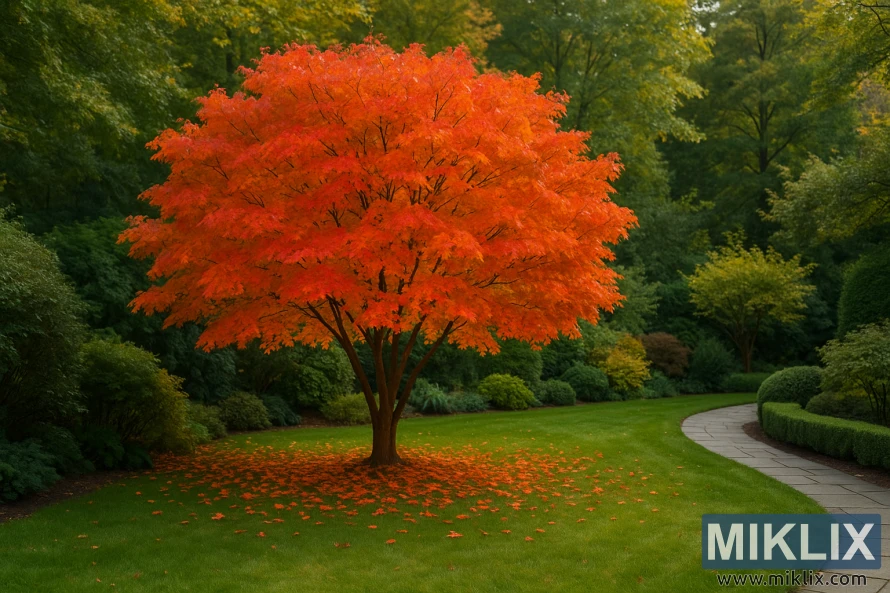
Planting and Care Tips for Garden Maples
Proper planting and maintenance are essential for helping your maple tree thrive. Follow these guidelines to ensure your tree establishes well and remains healthy for years to come.
Site Selection and Preparation
Most maple trees prefer well-drained soil with consistent moisture. Consider these factors when selecting a planting location:
- Sunlight requirements: Most maples thrive in full sun to partial shade. Japanese maples generally prefer afternoon shade in hotter regions.
- Soil conditions: Aim for slightly acidic to neutral soil (pH 5.5-7.0). Most maples prefer moist, well-drained soil rich in organic matter.
- Spacing: Consider the mature spread of your chosen variety and allow adequate room for growth. Avoid planting large maple species within 20 feet of structures.
- Microclimates: Japanese and fullmoon maples benefit from protection from harsh winds and afternoon sun in hot climates.
Planting Process
Follow these steps for successful maple tree planting:
- Dig a hole twice as wide as the root ball but no deeper than the root ball height.
- Gently remove the tree from its container and loosen any circling roots.
- Position the tree so the root flare (where trunk widens at base) sits slightly above ground level.
- Backfill with native soil, avoiding amendments in the planting hole.
- Create a water basin around the tree and water thoroughly.
- Apply 2-3 inches of mulch in a circle around the tree, keeping it away from the trunk.
Proper planting depth is critical for maple tree establishment and health
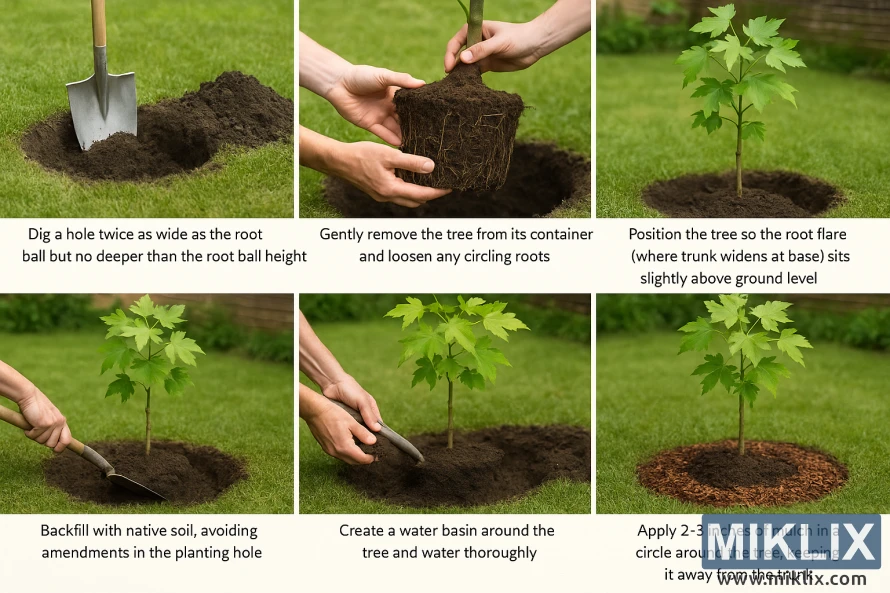
Ongoing Care and Maintenance
Keep your maple tree healthy with these care practices:
- Watering: Provide regular deep watering during the first 2-3 years. Once established, most maples need supplemental water only during drought.
- Fertilization: Apply a balanced, slow-release fertilizer in early spring if growth seems sluggish or foliage lacks vigor.
- Pruning: Prune in late winter or early spring before sap flow begins. Remove dead, damaged, or crossing branches to maintain structure.
- Mulching: Maintain 2-3 inches of mulch around the tree, refreshing annually but keeping it away from the trunk.
- Protection: Shield young trees from lawn equipment damage and consider trunk wraps in winter for thin-barked species.
Frequently Asked Questions About Maple Trees
Which maple trees have the best fall colors?
Sugar maples consistently offer the most spectacular fall display with their orange-red foliage, followed closely by red maples with their reliable scarlet colors. Japanese maples provide excellent fall color in a more compact package, with cultivars ranging from golden yellow to deep crimson. For smaller gardens, Amur maple delivers brilliant red autumn foliage on a more manageable scale. Fall color intensity is enhanced when trees receive adequate sunlight and experience cool night temperatures in autumn.
Are maple tree roots invasive near houses?
Some maple species do have aggressive root systems that can potentially damage foundations, sidewalks, and underground utilities. Silver maples are particularly notorious for surface roots and should be planted at least 30 feet from structures. Norway maples also have invasive root systems. For planting near houses, better choices include Japanese maple, paperbark maple, and trident maple, which have less aggressive root systems. As a general rule, plant large maple species at a distance equal to or greater than their mature canopy spread from foundations and underground utilities.
How can I control maple tree size in my garden?
To manage maple tree size, start by selecting naturally smaller species like Japanese maple, Amur maple, or paperbark maple. For existing trees, regular pruning in late winter can help control size. Focus on thinning branches rather than topping, which can damage the tree's structure and health. Container growing is another effective method for limiting size, particularly with Japanese maples. Some dwarf cultivars like 'Shaina' (Japanese maple) or 'Compactum' (Amur maple) naturally stay smaller without extensive pruning. Remember that severe pruning can stress trees and make them more susceptible to disease.
When is the best time to plant maple trees?
The optimal planting time for maple trees is during the dormant season—in fall after leaf drop or in early spring before bud break. Fall planting (September to November in most regions) is often ideal as it allows roots to establish before summer heat arrives. Spring planting (March to early May) can also be successful if followed by attentive watering during the first growing season. Avoid planting during summer months when heat stress can compromise establishment. Container-grown maples can technically be planted any time the ground isn't frozen, but will require more careful attention to watering if planted during the growing season.
How long do maple trees live?
Maple tree lifespan varies significantly by species. Sugar maples are among the longest-lived, frequently reaching 200-300 years in favorable conditions. Red maples typically live 80-100 years, while Japanese maples can survive 100+ years with proper care. Shorter-lived species include silver maple (60-80 years) and Amur maple (50-75 years). Factors affecting longevity include growing conditions, maintenance practices, and environmental stressors. Urban maples generally have shorter lifespans than those growing in natural settings due to soil compaction, pollution, and space constraints.
Conclusion
Maple trees offer extraordinary versatility and beauty for garden settings, with options suitable for nearly every landscape situation. From the delicate elegance of Japanese maples to the majestic presence of sugar maples, these remarkable trees provide multi-season interest while enhancing your outdoor living space.
When selecting the best maple trees for your garden, consider your specific site conditions, available space, and aesthetic preferences. By matching the right maple species to your garden environment, you'll create a lasting landscape feature that delivers beauty through every season and increases in value as it matures.
Further Reading
If you enjoyed this post, you may also like these suggestions:
- The Best Birch Trees for Your Garden: Species Comparison and Planting Tips
- A Guide to the Best Varieties of Redbud Trees to Plant in Your Garden
- Best Oak Trees for Gardens: Finding Your Perfect Match
